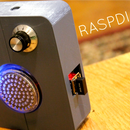Introduction: Open Sesame
The user flashes a QR Code (or accesses a website) to ring a door bell in a remote location.
++++++
Operation Principle:
When the user accesses the website, an ajax call is performed which changes the contents of a .txt file to "on". The Raspberry Pi checks this file every second. If it detects a change, it plays the sound and changes the contents of the .txt file to "off". The web interface then updates to tell the user that the bell has rung.
Created @ ICAH
Step 1: Get Your Material.
You will need a:
- Raspberry Pi
- wifi dongle (e.g. Edimax EW-7811Un)
- speakers
- a sheet of mdf (4mm)
- A web hosting service (e.g. GoDaddy, Hostgator, etc)
- A laser cutter
Step 2: Web File Upload
Create a directory on your web server & add the files in the folder "web.zip". You can use an FTP client (e.g. Filezilla).
When visiting http://yourwebsite/directory you should see the interface.
++++++
The folder web.zip contains 6 files:
- index.html : the main entry point. contains the DOM structure
- style.css: the css
- status.txt: a text file storing the values "on" or "off" depending on whether the sound has been played
- ajax.php: php scripts to check the status.txt file
- script.js: js scripts to perform ajax calls
- doorbell.svg: icon to display on the screen
Step 3: Configure the Wifi on the Raspberry Pi
To configure the wifi:
1. Boot the Raspberry Pi and run: sudonano etc/network/interfaces
Edit the file so that it looks like:
etc/network/interfaces auto lo iface lo inet loopback iface eth0 inet dhcp allow-hotplug wlan0 iface wlan0 inet manual wpa-roam /etc/wpa_supplicant/wpa_supplicant.conf iface default inet dhcp
2. Run the command: sudo nano etc/wpa_suppilicant/wpa_suppilicant.conf
- If you are on a WPA-EAP network, edit the file so that it looks like:
ctrl_interface=DIR=/var/run/wpa_supplicant GROUP=netdev<br>update_config=1</p><p>network {ssid=""
key_mgmt=WPA-EAP
password=""
identity="" }- If you are on a WPA-PSK network, edit the file so that it looks like:
ctrl_interface=DIR=/var/run/wpa_supplicant GROUP=netdev<br>update_config=1</p><p>network {ssid=""
key_mgmt=WPA-PSK
psk=""}Step 4: Add the Files to the Raspberry Pi
You can clone all files to the raspberry pi from my github by using:
git clone https://github.com/gcool-info/connected-doorbell.git
(if you haven't installed git on your Pi, you can run: sudo apt-get install git)
Otherwise, just copy the files main.py, launcher.sh, audio.mp3 in some directory on your Pi.
Make sure to change the lines:
response = http_request(http://yourURL/status.txt")
and
http_request("http://yourURM/ajax.php?cmd=turn_off")so that they point to your URL.
Step 5: Run Program on Pi Boot
To run the program immediately when the Pi boots up, we use a crontab. A crontab is a background (daemon) process that lets you execute scripts at specific times. It's essential to Python and Raspberry Pi. To do this, open the file launcher.sh
nano connected-doorbell/pi/launcher.sh
Make sure that the line
cd home/pi/connected-doorbell/pi
is pointing to the directory containing your main.py program.
Then, follow this excellent tutorial:
https://www.instructables.com/id/Raspberry-Pi-Launc...
(starting from step 2)
Step 6: Create the Poster
Generate a QR code for your url by visiting this website: http://www.qrstuff.com/
Open the poster.svg file & edit it with your favorite vector editing software (e.g. illustrator, inkscape, etc)
Attachments
Step 7: Laser Cut and Assemble!
Laser cut the house & the case for the raspberry pi.
Done!












